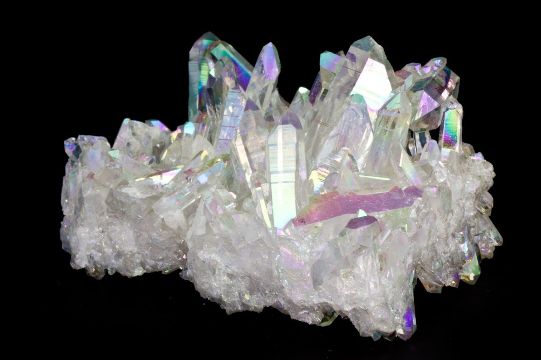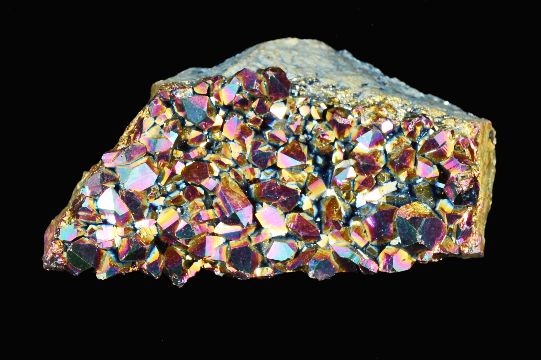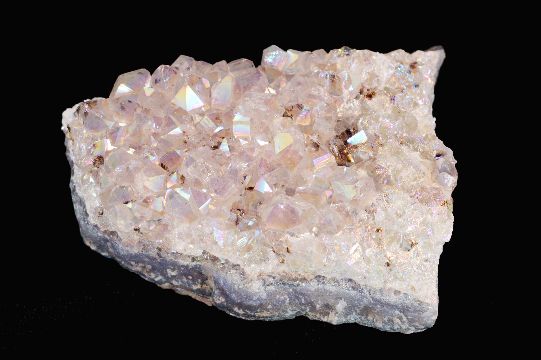Aura Quartz Crystal – Mineral and Healing Properties
Chemistry: Continuous framework of SiO4 silicon oxygen tetrahedra, with each oxygen being shared between two tetrahedra, giving an overall formula SiO2.
Class: Silicates
Subclass: Tectosilicates
Uses: Extensive



Few can resist the beauty of aura quartz crystals with their shimmering iridescence and metallic rainbow sheen in colors that defy nature yet enchant senses.
Angel Aura Quartz, also called Rainbow Aura Quartz, exhibits a light blue, rainbow and silvery iridescence like the gossamer wings of angels. Angel Aura is created when Clear Quartz crystals are super-heated in a vacuum and infused with vaporized Silver & Platinum. These precious metals condense onto the surface of the quartz crystal to form a permanent bond with the lattice of the quartz.
Flame Aura Quartz is Clear Quartz bonded with Titanium and Niobium and produces very deep blue, violet and golden metallic crystals.Quartz is the second most abundant mineral in the Earth’s continental crust, after feldspar.
Quartz is made up of a continuous framework of SiO4 silicon oxygen tetrahedra, with each oxygen being shared between two tetrahedra, giving an overall formula SiO2 and belongs to the trigonal crystal system. The ideal crystal shape is a six-sided prism terminating with six-sided pyramids at each end. In nature quartz crystals are often twinned, distorted, or so intergrown with adjacent crystals of quartz or other minerals as to only show part of this shape, or to lack obvious crystal faces altogether and appear massive.
Origin Of The Name
The word “quartz” is derived from the German word “quarz” and its Middle High German ancestor “twarc”, which probably originated in Slavic (cf. Czech tvrd (“hard”), Polish twardy (“hard”). Quarz which is of Slavic origin (Czech miners called it kremen). Other sources attribute the word’s origin to the Saxon word Querkluftertz, meaning cross-vein ore.
Roman naturalist Pliny the Elder believed quartz to be water ice, permanently frozen after great lengths of time. (The word “crystal” comes from the Greek word “ice”.)
Interesting Facts
Quartz is the most common material identified as the mystical substance maban in Australian Aboriginal mythology. It is found regularly in passage tomb cemeteries in Europe in a burial context, such as Newgrange or Carrowmore in the Republic of Ireland. The Irish word for quartz is grian cloch, which means ‘stone of the sun’. Quartz was also used in Prehistoric Ireland, as well as many other countries, for stone tools; both vein quartz and rock crystal were knapped as part of the lithic technology of the prehistoric peoples.
Quartz is the hardest of common minerals. Only rare minerals, such as diamonds, are harder than quartz. Quartz has many uses. It is used to make mortar and glass. Lenses are made from rock quartz.
The French scientist Pierre Curie discovered in the 1880’s that slices of quartz crystals become electrically charged when squeezed. Because of this property, quartz is used in radio, television, radar and in highly accurate clocks. Pure quartz consists of only two elements – silicon and oxygen. It is clear and glass-like.
Where Is It Found
Amethyst are Brazil, Uraguay, Mexico, Russia, Thunder Bay area of Canada, and some localities in the USA.
For Smoky Quartz; Brazil, Colorado, Scotland, Swiss Alps among many others. Rose Quartz is also wide spread but large quantities come from Brazil as do the only large find of Rose Quartz prisms. Natural citrine is found with many amethyst deposits but in very rare quantities.
Fine examples of Rock crystal come from Brazil , Arkansas, many localities in Africa, etc. Fine Agates are found in, of course, Brazil, Lake Superior region, Montana, Mexico and Germany.
What Do We Do With It
Quartz’s use in the glass blowing industry has been centered around its excellent corrosion resistance and ability to stay rigid under extreme temperatures. The quality of Quartz in the industry is determined by the amount of moisture in the silicate structure, the higher the content, the better the quality.
Quartz crystals have piezoelectric properties; they develop an electric potential upon the application of mechanical stress. An early use of this property of quartz crystals was in phonograph pickups. One of the most common piezoelectric uses of quartz today is as a crystal oscillator. The quartz clock is a familiar device using the mineral. The resonant frequency of a quartz crystal oscillator is changed by mechanically loading it, and this principle is used for very accurate measurements of very small mass changes in the quartz crystal microbalance and in thin-film thickness monitors.Quartz’s piezoelectric properties were discovered by Jacques and Pierre Curie in 1880.
Among the many other uses of quartz include, owing to its hardness and corrosion resistance quartz is often used to make abrasive items such as sandpaper, whetstones for sharpening edged tools or knives, used for kitchen countertops given that it is not extremely porous and so food particles and fluids do not get trapped in it, used to make crucibles which are basically vessels that do not melt easily and are employed for performing for high temperature chemical reactions, can channelize ultra violet light and therefore is used for manufacturing UV prisms and lenses, is used in quartz wristwatches, clocks, computers, mobile phones, radios, television receivers and navigational instruments that function with the help of a quartz oscillator, used for making glasses of all kinds including fiber glass and container glass, silica based quartz sand is often used as foundry sand which is blended with cohesive agents such as clay and oil, among others, and then used for the purpose of molding and casting, quartz sand is also added to molten metals so that it bonds with impurities which then can be easily removed.
Metaphysical Uses
Quartz is a programmable stone. Breaks bad habits, relieves headaches, channeling stone and enhances life force. Works with all chakras. Quartz – the greatest of all healing stones. Acts as an amplifier for psychic energy and aids meditation and visualization.
Angel Aura Quartz carries a very loving and sweet energy, stimulating the spirit and elevating one’s mood. Meditating with this crystal allows one to enter a state of serenity and peace, purification and rest, and to go beyond the body to perceive and receive help from one’s angel guides. Angel Aura assists in remembering lessons from past incarnations and attuning to one’s spiritual purpose. It is a marvelous aid for recognizing beauty, from Nature and Spirit, from within, and in others.
Use Angel Aura at the Throat Chakra for loving communications, in romantic pursuits, in caring for children and the aged, and in all healing situations. It may also be used to align and purify all chakras, allowing for the Rainbow Light Body activation and integration. Angel Aura is an all-healer, harmonizing one’s energy field with the physical body.
Flame Aura stimulates the Third Eye and Higher Crown Chakras, enhancing focus and increasing the ability to read people at an energetic and subtle level and to understand the information that was communicated. It is a beneficial stone for creating and maintaining a state of homeostasis within the physical and emotional bodies, and may be useful in the treatment of diabetes, cellular and bone cancers, Multiple Sclerosis, and in stimulating the immune system of AIDS patients.
Physical Characteristics
Color: Variable as the spectrum, but clear quartz is by far the most common color followed by white or cloudy (milky quartz). Purple (Amethyst), pink (Rose Quartz), gray or brown to black (Smoky Quartz) are also common. Cryptocrystalline varieties can be multicolored.
Luster: Glassy to vitreous as crystals, while cryptocrystalline forms are usually waxy to dull but can be vitreous.
Transparency: Crystals are transparent to translucent, cryptocrystalline forms can be translucent or opaque.
Crystal System: Trigonal; 3 2
Crystal Habits: Widely variable but the most common habit is hexagonal prisms terminated with a six sided pyramid (actually two rhombohedrons). Three of the six sides of the pyramid may dominate causing the pyramid to be or look three sided. Left and right handed crystals are possible and identifiable only if minor trigonal pyramidal faces are present. Druse forms (crystal lined rock with just the pyramids showing) are also common. Massive forms can be just about any type but common forms include botryoidal, globular, stalactitic, crusts of agate such as lining the interior of a geode and many many more.
Cleavage: Very weak in three directions (rhombohedral)
Fracture: Conchoidal
Hardness: 7
Specific Gravity: 2.65
Streak: White
Associated Minerals: Numerous and varied but here are some of the more classic associations of quartz (although any list of associated minerals of quartz is only a partial list): amazonite a variety of microcline, tourmalines especially elbaite, wolframite, pyrite, rutile, zeolites, fluorite, calcite, gold, muscovite, topaz, beryl, hematite and spodumene.
Best Field Indicators: First the fact that it is very common (always assume transparent clear crystals may be quartz), crystal habit, hardness, striations, good conchoidal fracture and lack of good cleavage.


